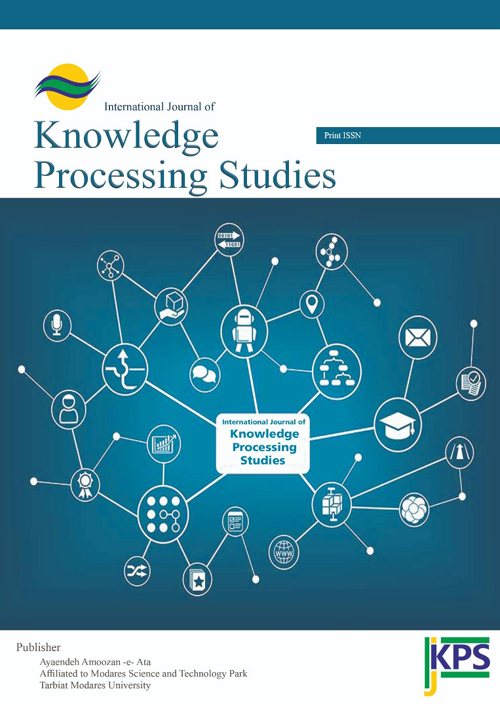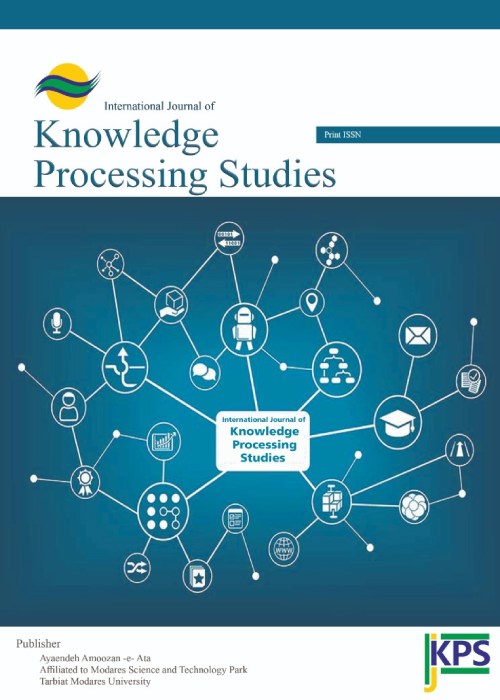فهرست مطالب

International Journal of Knowledge Processing Studies
Volume:2 Issue: 2, Spring 2022
- تاریخ انتشار: 1401/03/01
- تعداد عناوین: 6
-
-
Pages 1-9Purpose
The study identified the characteristics of scientific products in the field of the semantic web application. This purpose has been done by studying six databases including Magiran, Sid, Normagz, Civilica, Comprehensive portal of humanities, and Ganj.
MethodThis study is a descriptive study with a scientometric approach. purposive sampling and the techniques of co-occurrence and social network analysis have been used. Data analysis was done with Ravar Matrix software, Gefi, and data mapping was done with VosViewer software.
FindingsThe frequency of scientific productions in the field of the semantic web application has been 188, among which the semantic web with a frequency of 23 is in the first place. The co-occurrence maps form eight thematic clusters. Data analysis among degree and betweenness centers showed that the semantic web and ontology, spatial database, and jurisprudence structures have the highest rate. Among the cooperation of universities, the University of Tehran has the most connections with other universities and research centers. The University of Tehran was ranked first. Islamic Azad University, Kerman Branch, Shahid Bahonar University of Kerman, and the Imam Reza International University of Mashhad are ranked first to third. The University of Tehran, Tarbiat Modares University, and the Malek Ashtar University of Technology have the highest degree of centrality of betweenness.
ConclusionThe Semantic Web is an interdisciplinary subject with many applications in all disciplines, and the results indicate its continuous growth status.
Keywords: Semantic Web Application, Scientometrics, Co-occurrence, social network analysis, Intellectual Structure of Knowledge -
Pages 10-14Purpose
This study was conducted in other to assess the access and use of internet resources for learning by the students of the Maharaja Sayajirao University of Baroda. To ascertain the use of internet resources for learning by students of the Maharaja Sayajirao University of Baroda. This study is to outline how students access the Internet resources available, also to examine the purposes of the students' use of Internet resources, and investigate the challenges in access and use of Internet resources by the students.
MethodThe survey research method was adopted for the study. The sample distribution was based on three (3) Faculties, also the data was collected for the study by using descriptive analysis.
FindingsGiven the findings of the study, it could be concluded that information in all issues on access and use of internet resources for learning has been one of the major challenges facing the educational system in most tertiary institutions.
Conclusionthe researchers recommended that the Maharaja Sayajirao University of Baroda should create more awareness concerning the existence of available internet resources in the University and how should be used.
Keywords: Records, Management, Records management policy, Registry -
Pages 15-21PurposeThis study examines the perceived impacts of ICT on knowledge sharing by academics at the Federal School of Surveying, Oyo.MethodThe descriptive survey design was adopted. However, the population of this study includes academics in the Federal School of Surveying, Oyo State. There are fifty-three (53) academics in the Federal School of Surveying. A simple random sampling technique was adopted to give all the respondents an equal chance of being selected for this study. A web-based questionnaire was designed using Google form and generated link was shared with academics in the Institutions. The link was shared on various groups of institutions via WhatsApp and Telegram groups. The questionnaire link was shared and responses were collected for two weeks.FindingsThe study found that skills such as internet accessing skills, word processing skills, email sending skills, presentation skills, and database searching skills are required for knowledge sharing. Poor electricity, slow internet network, and lackadaisical attitude toward information managers are identified as challenges that influence the use of ICT in sharing of knowledge among academics in the Federal School of Surveying, Oyo state.ConclusionThe study recommends that Orientation, workshops, and training should be provided to academics of Federal School on the need to share knowledge.Keywords: ICT, Knowledge, Knowledge Skills, academics, surveying
-
Pages 22-30PurposeThe purpose of this study is to create Brand equity by using social media marketing and the structural equation method. The target society is the users of Telegram and Instagram networks of Samsung mobile phones.MethodIn this research, an unlimited sampling method has been used to collect data from social network questionnaires and Brand equity. Electronic questionnaires were designed to facilitate data collection and access to social network users. After collecting data, the data were analyzed by using LISREL9 and SPSS23 software.FindingsBased on the results of the research, the dimensions of social networks affect Brand equity. Entertainment, interaction, personalization, and word-of-mouth marketing (WOMM) in this study had a direct and significant effect on Brand equity. According to the rankings, in social media marketing, the brand association has the highest rank.ConclusionIn light of the findings obtained from the study, it could be said that businesses can increase their brand value perception with planned and well-defined social media marketing strategies. With social media marketing, businesses can gain significant advantages in many areas such as brand loyalty, reduced advertising expenses, increased profitability, access to a large consumer audience, and altered brand attitudes toward purchasing behavior.Keywords: Marketing, Social Media, brand equity, Customer Behavior
-
Pages 31-40PurposeThe purpose of this study is to answer the main question of what is meant by the concept of data-driven digital transformation from the perspective of cyber-physical-social systems’ thinking.MethodComparative Evaluation method is used in this study. In this method, after identifying different definitions and interpretations of the digital data-driven transformation and also cyber-physical-social data, these definitions are compared based on this method. Based on this analysis, then a conceptual concept from the perspective of the notion of cyber-physical-social systems for the concept of data-driven digital transformation is proposed.FindingsBased on this research, the concept of digital transformation has different definitions and interpretations. Some of these definitions focus on “what” and some on “how”. But the complex nature of the concept of transformation has not been noted enough. Now we’re cyber-physical-social systems as a platform for data creation and data flow. The nature of these systems is based on transformation and the digital data-driven transformation is achieved by data flow management in these systems.
Digital data-driven transformation is a concept based on digital convergence between social, physical, cognitive, and cyber systems. These systems are the context of creating big data, and data flow management requires data-driven notions and analytics, which is essential for the transformation and sustainability of societies.ConclusionAccording to the proposed framework, data-driven digital transformation is a concept based on digital convergence between social, physical, cognitive, and cyber systems. These systems are the context of creating big data, and data flow management requires data thinking and analytics which are necessary for the transformation and sustainability of societies.Keywords: Data-Driven Digital Transformation, Cyber-Physical-Social systems, Sociocybernetics -
Pages 41-52PurposeThis study aimed to identify and study the features and capabilities of common knowledge management software and its components in Iran. Then, a suitable model for producing knowledge management software for Iranian companies and organizations was presented.MethodThis study is a two-dimensional (basic-applied) research in terms of purpose and documentary-library research in terms of the method of collecting information. The statistical population is all knowledge management software, the number of which is unknown. A total of 12 common and widely used softwares were selected by available methods. Colaizzi's descriptive phenomenological approach was used to analyze the content. Validity and reliability were used through 4 criteria of credibility, reliability, verifiability, and transferability.FindingsAs a result of content analysis of sites related to knowledge management software, 120 categories or initial code and 40 indicators or final concepts were identified. After screening and refining the initial codes and indicators, the number of initial codes was reduced to 83, and the number of final indicators or concepts to 27 concepts.ConclusionIn the study, several common knowledge management software in Iran have been identified and their modules have been studied. Considering the culture, structure, and needs of organizations, and also considering the challenges faced by the knowledge management process in the organization, a suitable model for providing knowledge management software has been provided.Keywords: organization, Knowledge Management, Knowledge Management Software


